Search results
56 results found.
56 results found.
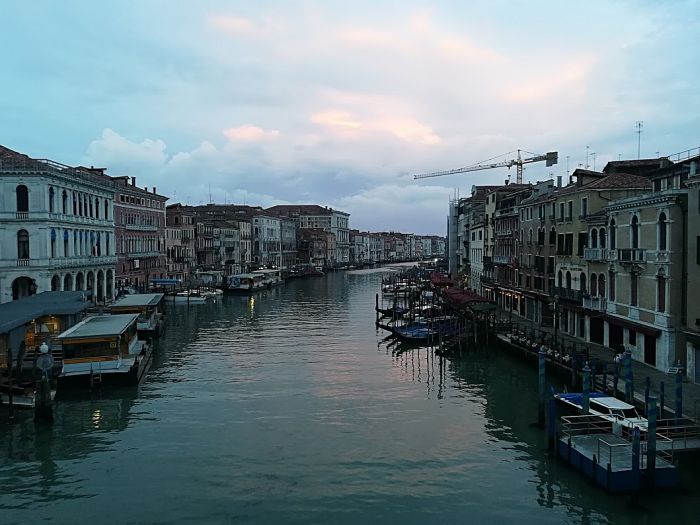
Another headline repeats what is becoming accepted wisdom: “Tourism is killing Venice, but it’s also the only key to survival.”
Apart from my inborn tendency to balk at the word “only” (in this case, is it true, or is tourism the only key you’ve come up with?), the phrase itself makes the same sense as “We had to destroy the village in order to save it.” “The operation was a success, but the patient died.” “Arsenic can kill you, but it’s the only thing we have to treat your late-stage trypanosomiasis.” Why do I keep linking tourism to death? That’s not good.
The quantity of tourists, as so many things, can be measured as “enough,” “more than enough,” and “far too much.” Sometimes these estimates are subjective (“I personally can’t find a seat anymore at my favorite cafe’, therefore there are too many people here”) to the clearly objective, like those overloaded Asian ferries that sometimes sink.
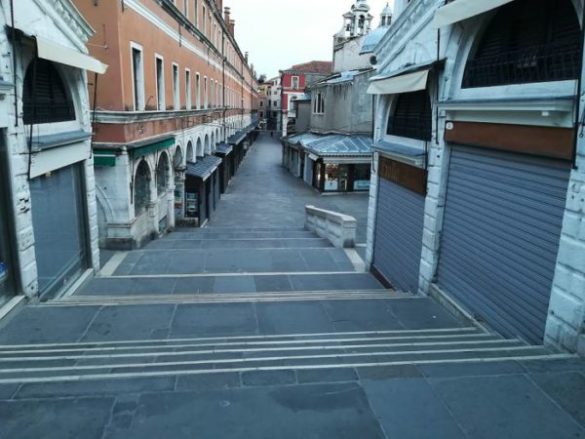
Venice’s plight is not unique. There are increasing numbers of places which are now under pressure from what once was a good thing, and they are trying different ways of managing it. Easter Island, if you’re interested, recently faced the fact that it was being subjected to a “veritable invasion of foreigners.” The 8,000 residents held a referendum and agreed to limit a tourist’s stay to 30 (as opposed to the previous 90) days, and soon will decide on a maximum number of tourists to allow at any one time, period.
Tourism to Iceland — a slightly less remote place — has increased five-fold since 2010. The population of Iceland is 332,000, and last year counted some 2,000,000 visitors. A tax is being discussed which would be applied in various ways to protect the spectacular natural environment from what amounts to six tourists for every resident.
Consider the gorgeous Croatian coastline. Rovinj, to take an example at random, has a population of 15,000; in 2017 there were 490,000 arrivals. Istria, the Croatian peninsula nearest to Italy, contains 208,000 residents; in 2017 there were 1,022,171 tourists from Germany alone.
Well, you say, when the shock has subsided, those are mostly summer destinations; obviously there’s breathing room there in the winter. And that’s true. But Venice is mostly a summer destination too.
Venice, so fragile, so small, obviously is facing its own perils, many based on chronic perplexity as to how to manage a place which has too many visitors to permit normal life, but which stubbornly insists on maintaining normal life anyway. Plans for peaceful coexistence that are hopefully suggested usually run aground on the reef of how to implement them. And there’s no way to ever make the city larger than three square miles.

Studies have shown that the sustainable limit of tourists to Venice is 19,000,000 a year. Last year 28,000,000 came, which is almost 50 percent more than the limit. The above study calculates that therefore Venice can sustain 52,000 tourists per day. We now have 77,000 per day. My own personal studies confirm that they will all be on the #1 vaporetto heading uptown on Sunday afternoon.
Speaking of vaporettos, they’re not your only option if you want to be crushed. Now the buses to Mestre in the late afternoon are reaching critical mass. So many tourists are packing the buses heading back to their much-less-expensive hotels, apartments, campgrounds, or wherever they’re staying on the mainland, that daily commuters literally can’t get on.
And if this is happening now, let me draw your attention to the several enormous hotels being built right next to the Mestre train station. Presumably their guests are going to want to go to Venice sometime, and even come back from Venice, on the already insufficient buses and probably soon-to-be-insufficient trains. Anybody is welcome to defend tourism, but I urge you once again not to say “Oh, but Venice lives on tourism” to any of the exhausted Venetians trying to get home as they watch the bus pull away without them.
The city government is struggling to find solutions to all this; it’s not like they don’t see what’s going on. The mayor recently announced that in the busiest periods he might close certain sections of the city to further entry. Something like this was tried a few months ago with “gates” at critical points, such as the Calatrava Bridge and the entrance to the Lista di Spagna, which were to slow, and redirect, the flood of arrivals heading toward San Marco from Piazzale Roma and the train station. It got mixed reviews and now the gates have been removed, though New Year’s Eve and Carnival desperation may require them to be reinstated.
Every time the topic of some form of entry tickets is raised, a thousand objections are heard. Entry is certainly easier to control at Easter Island, which is reachable only by means of a five-hour flight from Chile, but there must be at least 20 ways to get to Venice if you really want to, including, but not limited to, swimming.
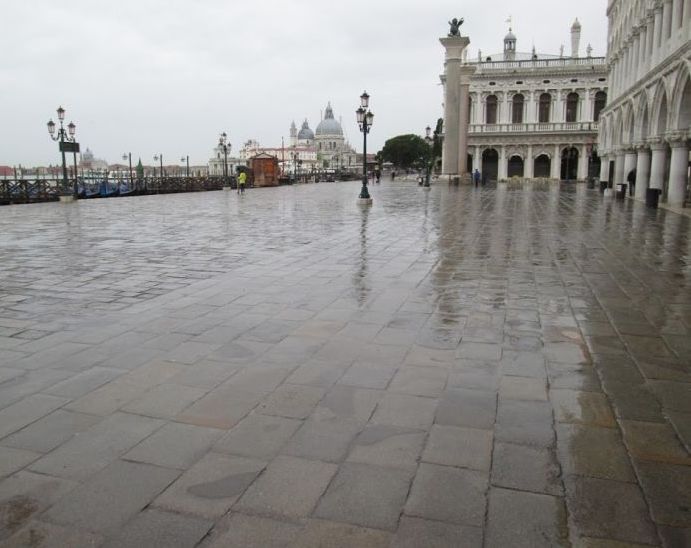
Managing crowds is an art and a science; the most striking example I know of is the reorganization of traffic in Mecca during the seven days of the annual hajj. Venice hasn’t reached the point where individuals are being trampled to death, but that was already a danger for the 2,000,000 Muslim pilgrims all trying to get to the same places together. A system has now been created to manage the flow better, so now we know it’s possible. It’s a fascinating story; here is a link to an interesting article on this amazing feat.
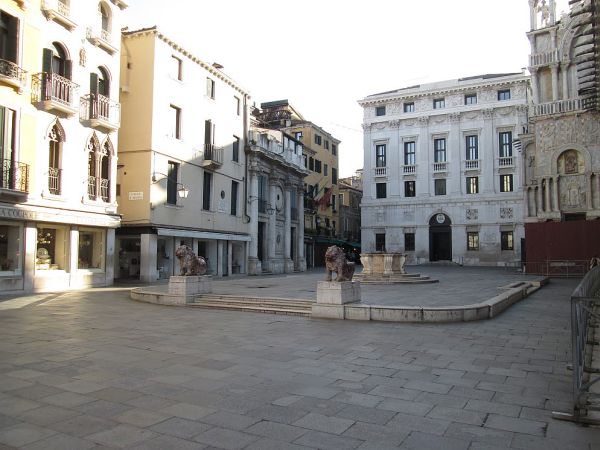
But “too many tourists” isn’t just numbers, it’s the ripple effect they have on Venetian life. I have recently noticed three effects of escalating tourism that are profound, even if not immediately perceived as such.
The first effect is the astonishing recent increase in supermarkets. A supermarket used to be a novelty, now it seems to have become a human right. There are even two, virtually side by side, on the Riva del Carbon near the Rialto Bridge.
I thought it would be interesting to find a map, or a list of the total number of supermarkets, but I didn’t and I don’t really care. They’re everywhere now. There’s the De Spar at the ex-Cinema Italia and literally two steps away is a Coop. Not literally ten steps away is a Conad, which used to be a Billa. Prix has inserted itself into all sorts of interesting corners, making it a challenge to find some of them although the lower prices make the search worthwhile, and there is a chain called Simply and something called Crai and so on.
If one knows — which one does — that the population of Venice is inexorably shrinking by about 1,500 people per year (despite a recent light touch on the brakes), it’s obvious that all these supermarkets haven’t been opening to support the few remaining locals. But when you consider the extreme increase of apartments being rented to tourists, voila’! I get it!
It’s clear that the dwindling population, including me, benefits from the supermarkets too. My point is merely that there wouldn’t be this number of emporia if locals were their only customers. Even I can understand that. But as I stand in line at the drastically expanded Coop on via Garibaldi it’s obvious that more than half of the people with me are tourists. And as I dodge their backpacks (yep, still on their backs, just like on the vaporetto) as they navigate the narrow aisles, I ask myself where the Sam Hill they all came from. I don’t mean what countries, I mean why are they all here now when five years ago there were so few? It’s like there’s a factory somewhere on a dark side street that’s manufacturing tourists.
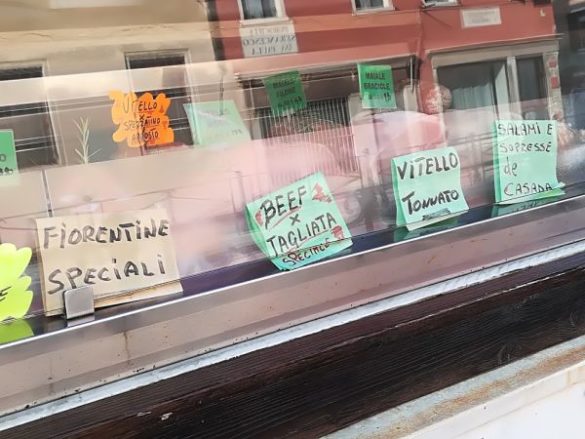
The second effect is the astronomical increase in apartments for short-term tourist rentals. By now this is not a new theme, but as I have often observed, you can hate AirBnb all you want (and it is far from the only outfit in this business), but if apartments are constantly being added to the supply available to tourists (and tourists respond by renting them, of course), why are these apartments being offered? To make money, naturally. And who is offering them? The Venetian landlords, naturally. While everyone is excoriating tourists for killing Venice, one should recognize who is handing them the ammunition. The shots, so to speak, are coming from inside the house.
One starts with the fact that there is very little space for locals to rent. The available space, which is increasing, is now primarily offered only to tourists. Some years ago, when Lino and I were requested to vacate the apartment we had rented for ten years, the landlady said she needed it for her cousin, or somebody, moving to Venice from Sicily, or somewhere. Any excuse will do, because of course she planned to rent it to students, which she did, demanding four times the rent we paid. Not made up.
But let that go. When we went looking for another rental somewhere — we weren’t fussy — no agency would talk to us because Lino’s Venetian (hence, theoretically impossible to dislodge). My being a foreigner was fine, as far as that went, but the point is that we weren’t in a position to pay the tourist-rental rates of — I think one agent said — 1,000 euros per week.
We managed, in the end, to buy our little hovel (we gave up on the rental idea), but we could manage. Yet there are extremely aged Venetians (a retired 90-year-old professor, in one case) who are being summarily evicted by their landlords because the apartment, which has now become a four-wall gold mine, is wanted for tourist rentals. The landlord says “I want my apartment back,” and a person who has been living in the place for 50 or 60 years is out on the street. There is no recourse. I am not making any of this up. A friend of mine told me a similar story of an elderly person in her building, “And the landlord is renting two other apartments already.”
This often-tragic upheaval is a clear response to the sheer quantity of tourists, but fingers in the press are pointed at the tourists. Why? As Lino puts it: “Who is forcing the Venetians to leave? The Venetians!” Therefore, if you look around and all you see is tourists, there are reasons.
A group called Occupy Venice has come forth with the goal of re-appropriating empty apartments (that is, those whose fate has not yet been sealed by tourism). A friend has sent an article which you can peruse.
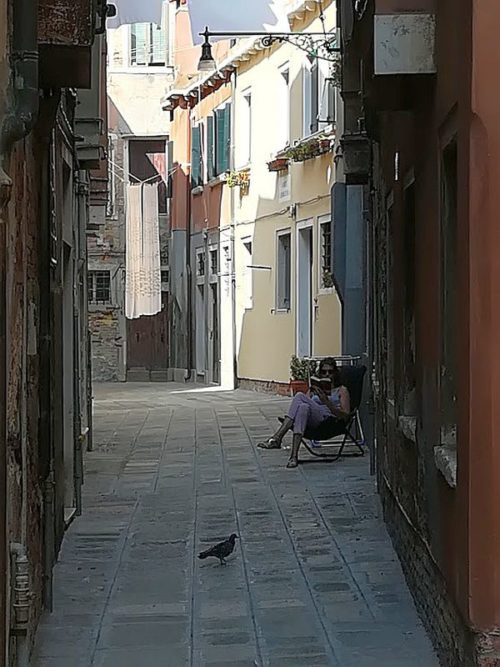
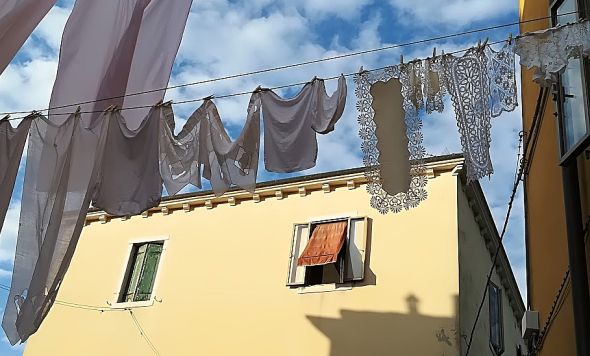
The third sign of increased tourism may not matter to anybody but me, so you can skip the next few paragraphs if you want.
I saw it on the day of the Regata Storica. This event focuses on four races which gloriously but inconveniently occupy the Bacino of San Marco and the Grand Canal for a total of three hours in the afternoon. This deranges the vaporetto routes, of course, and this year it was decided (one always wonders by whom) that this derangement was no longer acceptable. Therefore, for the first time in at least 100 years, the traditional “boa” in front of the train station was moved further downstream to just before the Cannaregio Canal.
“So what?” you ask. The “boa” is a temporary object which the racers turn around in order to head back down the Grand Canal toward the finish line. Tradition has always placed it in front of the train station, where there’s plenty of room for the boats to maneuver and plenty of room on the piazza in front of the station from which tourists can watch this usually dramatic moment. Win-win for everybody?
Of course not, because now there are enough tourists (or even some locals, I guess) who don’t care about the races and who are inconvenienced by not having vaporetto service from Piazzale Roma up the Cannaregio Canal during those few hours. One might regard the Regata Storica as the city’s festival, but no longer does the entire city celebrate.
Therefore moving the boa enabled the vaporettos to continue to navigate the upper reaches of the Grand Canal, unhindered by those pesky races. So another intangible, but no less real or important, piece of Venetian life has just been distorted (I didn’t want to say “eliminated,” but eliminated) for the benefit of I actually do not know whom. Because for many decades this temporary interruption of service didn’t create insurmountable problems for anyone. Does this change mean that now the number of “anyone” has superseded the number of those who want to see the Regata? Evidently yes.
The newspaper chronicles the craziness of the tourists, but crazier things keep happening below the proverbial radar. As in the case of the Fondaco, it’s the people in offices who actually have the destiny of the city in hand, and it will be a cold day in the Inferno when any regular Venetians might be consulted on the matter. But why consult them? Before long they’re all going to be dead. So bring on the tourists!
We need to move out of this dark tunnel now; I have a happy story to tell you.

A few days ago Lino and I were on the vaporetto going down the Grand Canal; it was late afternoon, that delectable moment in which you feel the heat of the day almost imperceptibly begin to subside and the faintest zephyr of coolness sweep over your sticky skin.
There were seats along each side of the boat’s bow, and everybody wants to sit there, of course: the view, the breeze, the general feeling of being the figurehead of the ship. The four forward-most seats on our side were occupied by a family, with the boy and his father on the left, the girl and her mother on the right. They weren’t talking much, mostly just relaxing and looking at the incomparable panorama as we trundled along. Tourists, of course, but calm, coherent tourists, acting like normal people.
As we passed the Customs House Point, where the Bacino of San Marco opens up to splendor on every side, the man reached across and touched his wife. She looked back and took his outstretched hand, and they silently squeezed, and smiled, gazing out at the glory.
Watching this, everything fell back into perspective and I was suddenly glad they were here. They weren’t just another four tourists, they were people who saw the beauty, and they were happy. It seemed that so many thoughts and emotions were being exchanged in that instant and I unexpectedly could imagine myself in their place, and I remembered how Venice made me feel the first time I came here, and I wanted that for everybody.
If all those too-many people who came to Venice could feel what they felt, then maybe we could find another word for them and stop calling them TOURISTS.

There are two fundamental problems concerning tourism here: Quality and quantity. They don’t blend any better than water and wax, but every year their doomed struggle to combine creates quite a spectacle.
Today the subject is “quality.”
We are beginning to reach the end of the Hating Tourists season, and I’ve been ruminating. I’m astonished to realize that by now even people’s most facepalming antics somehow don’t anger me anymore. I never thought I’d say that, but reading the headlines has become like watching a sitcom with the sound turned off. Honey, didn’t we already see this episode?
Perplexity, though, has replaced anger, because I still can’t understand why so many normal 21st-century people, when they find themselves away from home, so often revert to behavior that is usually discouraged in kindergarten. And it’s not just here — the same things go on elsewhere, in what seems to be a sort of Grand Tour of slobs and boors. In Rome the other day some young men/old boys were caught splashing and frolicking in the fountain by the Altare della Patria, whose centerpiece is the Tomb of the Unknown Soldier. Yes, we were in the depths of an appalling heat wave, but still. This would be like someone toasting marshmallows over the Eternal Flame in Arlington Cemetery. I mean, just don’t.
Hence the question in the title — does tourism make people crazy, or do they already have to be crazy in order to tour in that special rude way they do? I still can’t decide.
I bring all this up because my recent post about the Fondaco dei Tedeschi (wrongness of) has inspired a number of emails from anguished Venice-loving readers who somehow feel guilty — their word — for being a tourist because by now the word seems to connote only those who behave in an uncouth, ridiculous, repulsive, or even dangerous way. They’re concerned that simply being a tourist means that they’ll be lumped with the rest of the herd.
Let me reassure you that anybody who can feel guilty for another person’s sins is not related in any way, even geographically, to that other person. I’m not sure it can be justified even theologically; I’ll have to check the fine print.
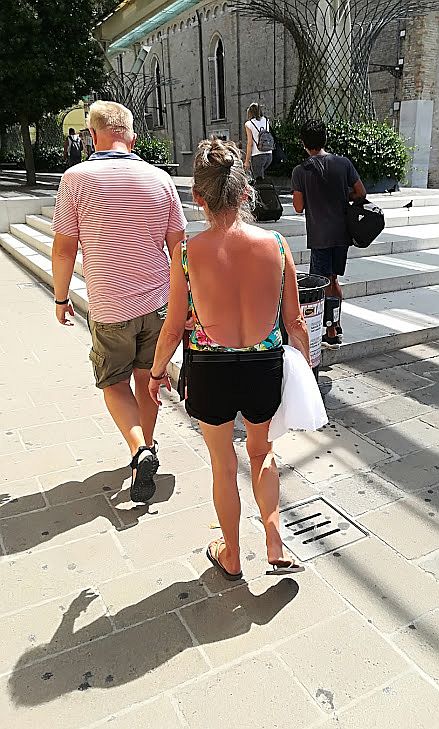
To make my point another way, let me ask my conscience-stricken readers (I love you, by the way): Would you string up a hammock between the trees at Sant’ Elena to take a snooze? Would you set up a camping tent on a fondamenta for the night? Would you steal a gondola at night (stealing is bad) without even knowing how to row (this is dumb)? Would you jump off the Rialto Bridge in a pink leotard (jumping is idiotic, as is the leotard, also that it’s pink) on a bet (bets are also stupid)? Extra points for the danger in this stunt, to yourself and others below you. No extra points for having a physique that’s worth showing off, though it’s well worth perusing, and points deducted for asking passersby to take your picture.
Would you slide into the Grand Canal in broad daylight and swim out into the traffic and wave happily at the passengers on the passing vaporetto?
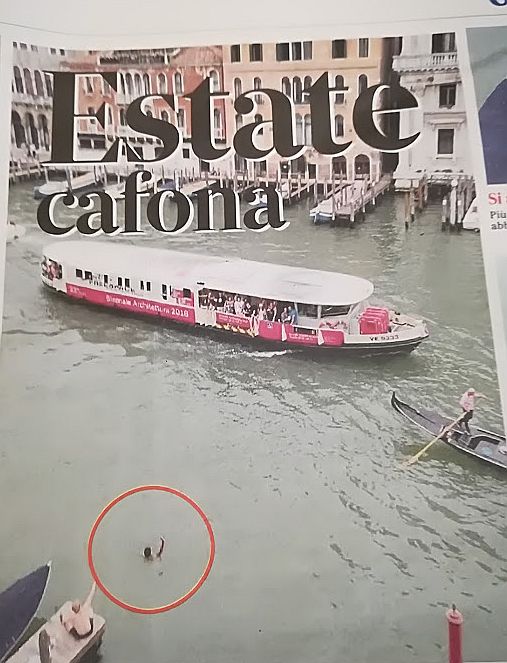
If the answer to any of the above is “Heaven forfend,” then we need to find another word for you, because you’re not what people have come to mean when they talk about tourists.
The city government is flailing around, trying to find a way to prevent all this. Fines! Twenty-four hours in jail! Banishment! (Not made up, though it’s not clear how the offenders would be identified on future visits.) Locals have been known to call the police when they see people jumping off bridges, and the police have been known not to show up.
It’s like whack-a-mole — the only thing these punishments are likely to accomplish is to assure (maybe?) that that specific individual won’t transgress again. As for the deterrent quality of punishment, I don’t think it exists if (A) the tourist doesn’t read the Gazzettino and (B) if the tourist believes that, seeing that lightning has struck someone else, they’re somehow exempt from being caught. Shame? Embarrassment? What?
So by now we’re all pretty accustomed to tourists jumping off bridges, but a few days ago one jumped off a vaporetto. A ticketless 18-year-old American girl traveling up the Grand Canal noticed that the ticket controller was beginning to pass through the crowd, and she realized that not having a ticket meant a 60-euro fine, plus the 7.50 euros for the ticket itself. Flee!
By which I mean: Jump into the Grand Canal! Which she did! Quick thinking! And expensive thinking! Because she was almost immediately plucked out of the water by a passing boat, and when the formalities were finished she had paid a fine of 528 euros ($611) — 450 for immersing herself in the canal, plus the ticket price and fine thereof. So she clearly had the 7.50, and even, if need be, the additional 60. (For the curious, the Gazzettino made a point of saying that her credit card had survived the saltwater bath.) But where did she think she was going when she made that big splash? She said she didn’t know it was forbidden to swim in the Grand Canal. It needs to be forbidden? It’s certainly forbidden to create problems for traffic, and that goes for boats who get in the way, too. Brain tired.
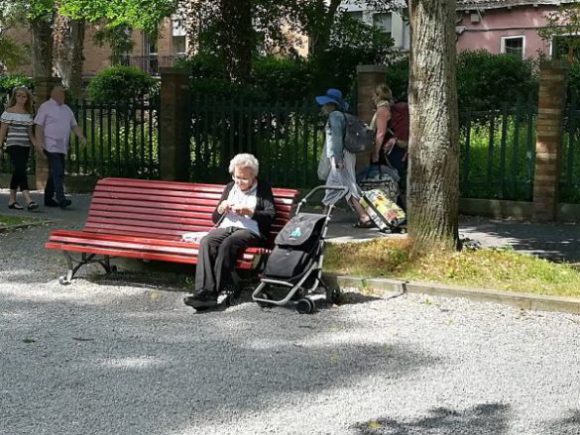
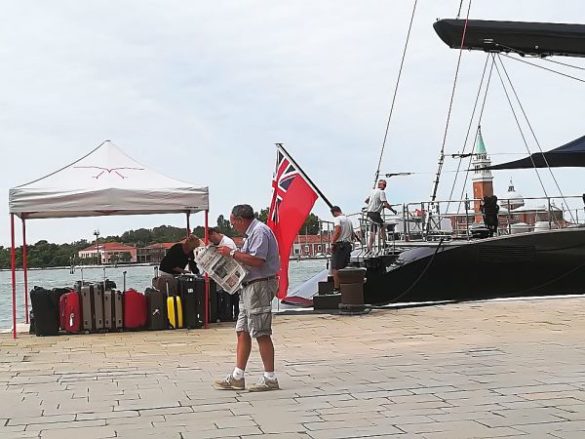
You don’t even have to do anything drastic to appear a little crazy. A friend who owns a pizzeria/bar at Sant’ Elena told me the other day that this has been a very unprofitable season so far; plenty of work, but little to show for it.
For instance, “A family of three came and ordered one pizza,” she said, “and a few drinks” (not alcohol, but something fizzy). “The bill came to 11 euros, and they complained. They wanted to know why it cost so much.”
People have begun to bring their own beverages to the table, she went on, or ask her to wash their bag of peaches so they can eat them there. Apart from the rustic quality of these requests, she points out that the law prohibits customers from consuming something not provided by her for the obvious reason that if something were to go wrong (food poisoning, etc.) she could unjustly be blamed. On a less legalistic level, customers like these make her tired and disheartened, because she’s working and they’re acting as if she’s just standing around asking for money.
But before we leave the topic of “quality,” it should be noted that there must be plenty of times that tourists behave strangely, but not enough to deserve a mention in the news.
A recent example: We now have two tourist apartments in our little snippet of street, and it isn’t easy for the occupants to follow the new scheme for garbage collection. The apartment owners leave some kind of instructions (it’s not clear how clear they are), but there are complications in that the normal squishy garbage is collected every morning except Sunday, while the recyclables are on alternate mornings (plastic on Tuesday, paper on Wednesday, etc.). There are other regulations too but I won’t go into them, because the point isn’t that there are regulations but that some people just find them intolerable.
So we learned from our Venetian neighbor upstairs that this morning he saw one of the current occupants of the facing apartment — for the record, usually rented to French people — walk out the front door with a backpack, peering importantly at his cell phone as he walked away. Our friend has a window looking out the other side as well, so he watched as the tourist walked to the far end of the dead-end street beyond, opened his backpack, took out a bag of garbage, and left it on the street.
When my friend confronted him (with descriptive gestures) to convey that this was not only not allowed, but was wrong in every way, the man just made similarly descriptive gestures to signify “I don’t understand” with those special gestures which indicate “And I totally don’t care.” This was probably not an isolated incident, and sirens go off in Venetian brains when foreigners warble “Oh, but Venice lives on tourism!” as if that makes everything okay.
The issue of “quality” was frankly acknowledged in a headline in the Gazzettino: “The chaos is keeping the elite tourists away.” That’s pretty blunt, and to say it must have been painful for the officials who annually express their longing to somehow induce the elite to return to Venice in a more regular, and abundant, manner.
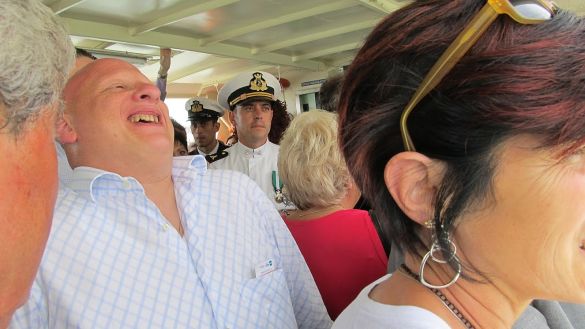
If there’s one thing I feel safe in saying, it’s that the elite are not attracted by chaos, unless you count the occasional quaint festival of the picturesque peoplefolk, which we seem to be short of (quaintness and peoplefolk). So, considering that the elite are drastically outnumbered, they’re going to have to renounce Venice and go spend their millions at Portofino or Porto Cervo or Portobuffole’ (not an elite spot, I just threw that in because I love the name), or wherever they go. But the city officials can’t accept defeat, so every year we read the same wistful statements about how much we miss the elite. They never write, they never call.
To sum up: To be a “good” tourist you don’t have to care — or even know anything — about Tintoretto or the 76th doge or how to make bigoli in salsa. You just have to know not to put your suitcase/backpack/house on the seat next to you on the vaporetto, or not to lie down to sunbathe in the middle of Piazza San Marco (or anywhere), and any other shenanigan that cannot be justified to your mother. If that seems unpleasantly restrictive, and not at all vacationlike, you should go to a real theme park, like Aqualandia, and leave Venice alone.
Therefore, to any visitor with misgivings about being a tourist: People here don’t hold it against you that you’re foreign. They hold it against you if you behave as if you come from the planet of failed experiments in genetic modification.
In my next post: “Does tourism make you crazy? Quantity”
I know it might seem that this subject just won’t go away, even if, as Mark Twain said about something else, you take a stick and hit it on the snout. But as it’s one of the central subjects of existence here, there is no escape.
I was interested to see the headline in the Gazzettino two days ago, “Venice doesn’t know how to keep its tourists.” This is intriguing, considering that much of the criticism hurled at tourism here seems to have to do with wanting the tourists to go away.
Just in case, though, that my recent disquisition on tourism might have seemed like the lonely ravings of a solitary misfit, a recent study by the Confindustria Venezia, a business consortium, which looked at Venice, Rome and Florence, has shown not only the brevity of the average stay (2.47 nights), but that tourists rarely return to Venice. And they say outright that, as I mentioned the other day, the city lacks a tourism strategy.
“The central point,” said Elisabetta Fogarin, president of Confindustria Venezia Turismo, “is that Venice needs a policy of Destination Management. It needs to be relaunched at the international level, to make it an icon and a glamour destination again, where the visitor and traveler can live an experience that can’t be repeated somewhere else.”
Glamour is the grail of tourism here, the notion that quality can be made to replace quantity in the economic equation. I’d suggest that this dream is something like wanting all trains to be like the Orient Express, including the Venice-Pordenone local. Which I would totally endorse, except that there are too many people who just need to get home from work to make that even imaginable.
The statistic of 2.47 nights here is, according to the study, a sign that Venice is drastically under-realizing its potential; in any case, it’s not indicative of “culture tourism” (for which one needs more time, clearly. Anybody who has entered the Uffizi Galleryin Florence with the intention of seeing it all knows that about five months is probably a more reasonable time frame for visiting some cultural monuments here.) And 2.47 nights is just another way of saying “not quality tourists.” Bearing in mind that to reach an average, you must have many people who are staying less time (and at least some who are staying longer, true.) But mostly tourists just hit and run.
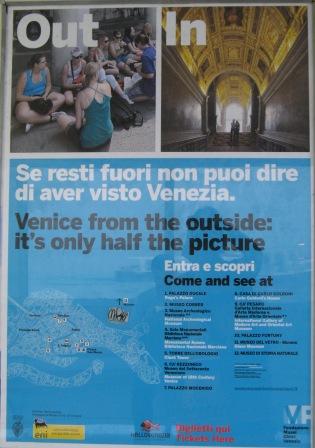 I think somebody has already recognized this and decided to play to Venice’s currently somewhat battered image. A new campaign promoting the city’s museums shows two scenes: One is a detail of the huddled masses in the Piazza San Marco, next to a shot of the magnificent Scala d’Oro in the Doge’s Palace, a ceremonial staircase dwarfing two lorn humans. The slogan in Italian translates as, “If you stay outside, you can’t say you’ve seen Venice.” Which I like better than the way they translated it, snappy as it may be.
I think somebody has already recognized this and decided to play to Venice’s currently somewhat battered image. A new campaign promoting the city’s museums shows two scenes: One is a detail of the huddled masses in the Piazza San Marco, next to a shot of the magnificent Scala d’Oro in the Doge’s Palace, a ceremonial staircase dwarfing two lorn humans. The slogan in Italian translates as, “If you stay outside, you can’t say you’ve seen Venice.” Which I like better than the way they translated it, snappy as it may be.
So to really see Venice, you have to get away from Venice? Well, I guess that’s as good an approach to crowd management as another. It just seems slightly regrettable that instead of promoting this monument for the wonder of the world that it is, this angle is more like “Want to get away from all those uncouth boors outside? Flee into our gorgeous past, which is deserted,” which actually sounds pretty good unless you know that this means you’re going to have to pay 13 euros ($18) to walk through endless non-air-conditioned rooms and look at a million paintings that all look alike. Or so it might seem if your primary motivation for entering was merely because it isn’t Out There.
I happen to worship the Doge’s Palace and consider it a given that if you don’t spend several hours here, you can’t have the tiniest notion of the greatness, brilliance and sheer power of the Venetian Republic. Without which, your visit to Venice is just a pointless trek through a flyblown postcard.
It’s just too bad to tell people they should see the museums because there aren’t any of those awful tourists there. But I guess if you have no tourism strategy, you’ll try all kinds of things.
Most of the journalism about Venice, either print or TV, points out tourism as Venice’s main defining characteristic, which is about as simple a discovery to make as that water fills the canals. Apparently the appeal is eternal to the average journalist and editor looking for a story which is immediately sensational and not at all hard to do. A story on tourism here practically writes and photographs itself.
In doing so the reporters universally bewail it, to one degree or another, in the same way one would bewail any uncontrollable natural disaster such as grasshopper swarms, tornadoes, avalanches. You’d almost think that tourists come to Venice deliberately to wreak havoc on an innocent, helpless, unsuspecting, undeserving victim. The lines in these stories are usually pretty clear: City Good, Tourist Bad.
Pictures of mass tourism at its most intense are the easiest images in the world to take, the journalistic equivalent of hitting the bull’s-eye from one foot away. Anybody can do it — I’ve done it myself. You don’t even have to open your eyes to take impressive pictures of the worst aspects of mass tourism. In fact it’s probably better if you don’t.
But there is much more to the situation than the simple outlines sketched by the just-passing-through journalists.
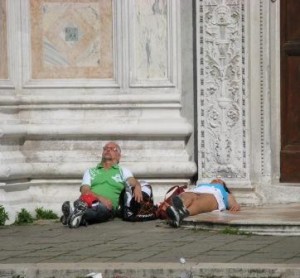
I am not defending the behavior of large segments of the mass tourist population. These are generically labeled “turisti da culo,” which literally means ass-tourists, but generally conveys a wide range of rude, thoughtless, generally sub-civilized behavior. There is never any lack of examples, especially in the summer. This race of tourist is horrifying, demoralizing, offensive, depressing. I could tell you stories. And yes, of course there are too many of them.
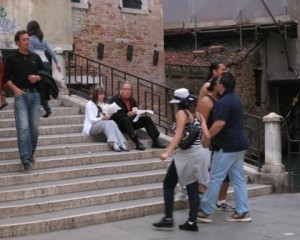
But I want to pause for a moment in mid-cliche’ to regard the situation from two important points of view which are rarely addressed as everyone is busy wailing and gnashing their teeth.
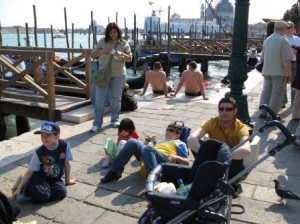
First, the city officials who have been assigned the role of City Councilor for Tourism over the years are politicians. They are not trained in the industry of tourism, an industry as demanding and complex as making steel or developing drugs. Further, it is the nature of the political breed to be cautious and easily swayed by conflicting demands, which makes planning, and then executing any plan, hugely difficult. And unappealing. Politicians on the whole tend to avoid “difficult” and “unappealing.” So a lot of tiny, disconnected actions are undertaken to minimize, if not solve, whatever is the most pressing problem of the moment.
The current Councilor for Tourism, a native Venetian lawyer named Augusto Salvadori, is famous for his impassioned oratory on behalf of his beloved city, the need to protect her and defend her and nourish and cherish her. It’s like the wedding vow. He is often on the verge of weeping before he finishes. People have come to expect it.
But he has no program, he has only little temporary fixettes. My favorite was the recent day to promote Decorum (yes, that’s the word they use for clean, tidy and polite), one of whose more publicized aspects was that the city offered to donate geraniums to anybody who wanted them, in order to brighten up the windowsills. If he had thought of donating the same number of large trash bins to be distributed far and wide to mitigate the incessant leaving of garbage on said windowsills because no alternative is to be found, the city wouldn’t need flowers in order to look better. You can walk from the vaporetto stop at San Pietro di Castello as far as the Bridge of the Veneta Marina (a straight shot of about 20 minutes, if you dawdle) without finding one (1) trash bin of any size whatsoever.
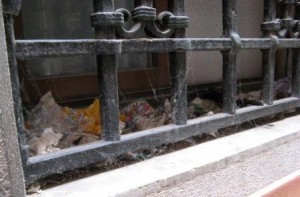
There aren’t many people who are willing to walk around town indefinitely with their empty soda can, beer bottle, or plastic ice-cream cup in their hand, searching for a place to dispose of it.
So: Point One is that the persons in charge of tourism here are unprepared for anything other than Making Suggestions. Which isn’t the same as Having Ideas.
Tourism is Venice’s only source of income. Yet it is inexplicably and profoundly — even stubbornly — even proudly, it sometimes seems — mishandled. The individuals charged with managing this important, complicated, potentially destructive resource could be compared to a person hired as director of a mercury mine whose previous job had been, say, as the Judges and Stewards Commissioner of the International Arabian Horse Association.
“We need some truly visionary people,” professor Fabio Carrera told me the other evening. “There’s no long-range thinking. It’s very short-range.” A few months ago there was tremendous blowing of trumpets and waving of banners to publicize “VeniceConnected,” the next big step in tourism management here: One-stop online booking. Carrera snorts. “All these ideas that were good maybe five years ago, like VeniceConnected online. We should be doing ten times better in the future. But they think ‘We’re innovating’ by doing this crap.”
The fact that there is chaos at the top naturally leads to chaos all the way down to the poor bastard trying to find a place in the shade to have some kind of lunch that won’t cost a fortune. Bathrooms — can’t find them. Open late, close early. Vaporettos — confusing. Signage — random and often homemade. 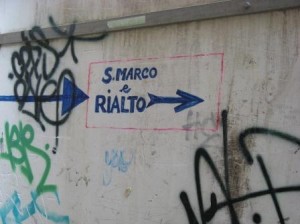 Street vendors — insistent and vaguely disturbing. Which leads to Point Two.
Street vendors — insistent and vaguely disturbing. Which leads to Point Two.
Point Two: Nobody ever takes the trouble to report on what is demanded of a tourist here. I see it every day and even as it repels me it also inspires something like pity. It must be the vacation equivalent of the Ranger Assessment Phase at Fort Benning, especially if you’ve got kids. I once stopped to help a family of three standing at the foot of a bridge with their eight suitcases (I counted them), unable to figure out where they were, much less how to get to their hotel. They had been standing there for a while.
Visiting Venice in the summer will almost certainly be hot, tiring, baffling, occasionally even upsetting, and it can cost far too much. A one-ride ticket on the vaporetto costing 6.50 euros ($9) is far too much. Two euros ($2.80) for a half-liter (two cups) bottle of water is far too much. Disposing of the result of the water you drank, if you avail yourself of one of the few but very clean municipal bathrooms costs 1.50 euros ($2), which is far too much. But cheaper than the original bottle of water, true.
I am not defending or excusing the type of tourist of which one sees way too many here: Oblivious, rude, loud, and often, yes, ugly. The garb, the behavior, the everything is impossible to defend. When people leave home, many evidently leave their manners at the kennel with the dog. (The fact that there can also be rude, loud, ugly Venetians is noted by the court, but doesn’t have any bearing on this case.) But to be a tourist here, enchanting as the city is, must be debilitating.
Still, that doesn’t explain why they have to shuffle around the narrow streets like wounded water buffalo, stopping with no warning and blocking your passage, or to ride the vaporetto with 60-pound packs on their backs, nonchalantly laying waste to everyone around them as they turn this way and that, admiring the view.
So let’s sum up the situation: The city puts up with aggravations and discourtesies and even damage, large and small, all day, every day, and also at night, but it gets money. And the tourist struggles around a bewildering, overloaded bunch of Baroque/Renaissance/Veneto-Byzantine-laden islands, but gets lots of pictures of canals and belltowers.
I don’t know. Something is definitely missing from these equations.